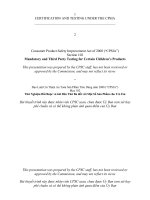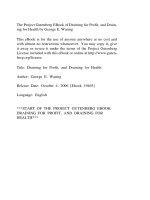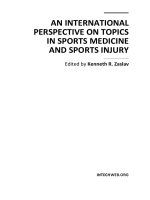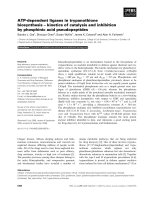Fat and Blood, by S. Weir Mitchell doc
Bạn đang xem bản rút gọn của tài liệu. Xem và tải ngay bản đầy đủ của tài liệu tại đây (886.79 KB, 447 trang )
The Project Gutenberg EBook of Fat and
Blood, by S. Weir Mitchell
This eBook is for the use of anyone
anywhere at no cost and with
almost no restrictions whatsoever. You
may copy it, give it away or
re-use it under the terms of the Project
Gutenberg License included
with this eBook or online at
www.gutenberg.net
Title: Fat and Blood
An Essay on the Treatment of Certain
Forms of Neurasthenia and Hysteria
Author: S. Weir Mitchell
Editor: John K. Mitchell
Release Date: July 7, 2005 [EBook
#16230]
Language: English
*** START OF THIS PROJECT GUTENBERG
EBOOK FAT AND BLOOD ***
Produced by Kathryn Lybarger, Janet
Blenkinship and the
Online Distributed Proofreading Team at
FAT AND
BLOOD:
AN ESSAY ON THE
TREATMENT OF
CERTAIN FORMS OF
NEURASTHENIA AND
HYSTERIA.
BY
S. WEIR
MITCHELL, M.D.,
LL.D. HARV.,
MEMBER OF THE
NATIONAL ACADEMY OF
SCIENCES.
EIGHTH EDITION.
EDITED, WITH ADDITIONS, BY
JOHN K. MITCHELL, M.D.
PHILADELPHIA:
J.B. LIPPINCOTT COMPANY.
LONDON: 5 HENRIETTA STREET,
COVENT GARDEN
1911.
Copyright, 1877, by J.B. LIPPINCOTT
& CO.
Copyright, 1883, by J.B. LIPPINCOTT
& CO.
Copyright, 1891, by J.B. LIPPINCOTT
COMPANY.
Copyright, 1897, by J.B. LIPPINCOTT
COMPANY.
Copyright, 1900, by J.B. LIPPINCOTT
COMPANY.
Copyright, 1905, by S. WEIR
MITCHELL.
ELECTROTYPED AND PRINTED BY
J.B. LIPPINCOTT COMPANY,
PHILADELPHIA, U.S.A.
PREFACE TO THE
EIGHTH EDITION.
The continued favor which this book has
enjoyed in Europe as well as in this
country has rendered me doubly desirous
to make it a thorough and clear statement
of the treatment of the kind of cases
which it discusses as carried out in my
practice to-day.
In the endeavor to do this, the present
edition, like the last two, has been
carefully revised by my son, Dr. John K.
Mitchell, and there is no chapter, and
scarcely a page, where some alteration
or addition has not been made, besides
those of the sixth and seventh editions,
as the result of added years of
experience. Especially in the chapters on
the means of treatment some details have
been thought worth adding to help the
statement so often repeated in the book
that success will depend on the care
with which details are carried out. The
chapter on massage, rewritten for the
last edition, has been once more revised
and somewhat extended, in order to
make it an accurate as well as a
scientific, if brief, statement of the best
method which use and observation have
taught us. A chapter on the handling of
several diseases not described in former
editions has been added by the editor.
S. WEIR MITCHELL.
SEPTEMBER, 1899.
CONTENTS.
PREFACE TO THE EIGHTH
EDITION.
CHAPTER I. INTRODUCTORY
CHAPTER II. GAIN OR LOSS OF
WEIGHT CLINICALLY
CONSIDERED
CHAPTER III. ON THE
SELECTION OF CASES FOR
TREATMENT
CHAPTER IV. SECLUSION
CHAPTER V. REST
CHAPTER VI. MASSAGE
CHAPTER VII. ELECTRICITY
CHAPTER VIII. DIETETICS AND
THERAPEUTICS
CHAPTER IX. DIETETICS AND
THERAPEUTICS—(Continued)
CHAPTER X. THE TREATMENT
OF LOCOMOTOR ATAXIA,
ATAXIC PARAPLEGIA, SPASTIC
PARALYSIS, AND PARALYSIS
AGITANS
INDEX.
CHAPTER I.
INTRODUCTORY.
For some years I have been using with
success, in private and in hospital
practice, certain methods of renewing
the vitality of feeble people by a
combination of entire rest and excessive
feeding, made possible by passive
exercise obtained through the steady use
of massage and electricity.
The cases thus treated have been chiefly
women of a class well known to every
physician,—nervous women, who, as a
rule, are thin and lack blood. Most of
them have been such as had passed
through many hands and been treated in
turn for gastric, spinal, or uterine
troubles, but who remained at the end as
at the beginning, invalids, unable to
attend to the duties of life, and sources
alike of discomfort to themselves and
anxiety to others.
In 1875 I published in "Séguin's Series
of American Clinical Lectures," Vol. I.,
No. iv., a brief sketch of this treatment,
under the heading of "Rest in the
Treatment of Nervous Disease," but the
scope afforded me was too brief for the
details on a knowledge of which
depends success in the use of rest, I have
been often since reminded of this by the
many letters I have received asking for
explanations of the minutiæ of treatment;
and this must be my apology for bringing
into these pages a great many particulars
which are no doubt well enough known
to the more accomplished physician.
In the preface to the second edition I
said that as yet there had been hardly
time for a competent verdict on the
methods I had described. Since making
this statement, many of our profession in
America have published cases of the use
of my treatment. It has also been
thoroughly discussed by the medical
section of the British Medical
Association, and warmly endorsed by
William Playfair, of London, Ross of
Manchester, Coghill, and others; while a
translation of my book into French by
Dr. Oscar Jennings, with an introduction
by Professor Ball, and a reproduction in
German, with a preface by Professor
von Leyden, have placed it satisfactorily
before the profession in France and
Germany.
As regards the question of originality I
did not and do not now much concern
myself. This alone I care to know, that
by the method in question cases are
cured which once were not; and as to the
novelty of the matter it would be
needless to say more, were it not that the
charge of lack of that quality is
sometimes taken as an imputation on a
man's good faith.
But to sustain so grave an implication
the author must have somewhere laid
claim to originality and said in what
respect he considered himself to have
done a totally new thing. The following
passage from the first edition of this
book explains what was my own
position:
"I do not wish," I wrote, "to be thought
of as putting forth anything very
remarkable or original in my treatment
by rest, systematic feeding, and passive
exercise. All of these have been used by
physicians; but, as a rule, one or more
are used without the others, and the plan
which I have found so valuable, of
combining these means, does not seem to
be generally understood. As it involves
some novelty, and as I do not find it
described elsewhere, I shall, I think, be
doing a service to my profession by
relating my experience."
The following quotation from Dr.
William Playfair's essay
[1]
says all that I
would care to add:
"The claims of Dr. Weir Mitchell
to originality in the introduction of
this system of treatment, which I
have recently heard contested in
more than one quarter, it is not my
province to defend. I feel bound,
however, to say that, having
carefully studied what has been
written on the subject, I can
nowhere find anything in the least
approaching to the regular,
systematic, and thorough attack on
the disease here discussed.
"Certain parts of the treatment
have been separately advised, and
more or less successfully
practised, as, for example,
massage and electricity, without
isolation; or isolation and
judicious moral management
alone. It is, in fact, the old story
with regard to all new things:
there is no discovery, from the
steam-engine down to chloroform,
which cannot be shown to have
been partially foreseen, and yet the
claims of Watt and Simpson to
originality remain practically
uncontested. And so, if I may be
permitted to compare small things
with great, will it be with this. The
whole matter was admirably
summed up by Dr. Ross, of
Manchester, in his remarks in the
discussion I introduced at the
meeting of the British Medical
Association at Worcester, which I
conceive to express the precise
state of the case: 'Although Dr.
Mitchell's treatment was not new
in the sense that its separate
recommendations were made for
the first time, it was new in the
sense that these recommendations
were for the first time combined
so as to form a complete scheme
of treatment.'"
As regards the acceptance of this method
of treatment I have to-day no complaint
to make. It runs, indeed, the risk of being
employed in cases which do not need it
and by persons who are not competent,
and of being thus in a measure brought
into disrepute. As concerns one of its
essentials—massage—this is especially
to be feared. It is a remedy with capacity
to hurt as well as to help, and should
never be used without the advice of a
physician, nor persistently kept up
without medical observation of its
temporary and more permanent effects.
CHAPTER II.
GAIN OR LOSS OF WEIGHT
CLINICALLY CONSIDERED.
The gentlemen who have done me the
honor to follow my clinical service at
the State Infirmary for Diseases of the
Nervous System
[2]
are well aware how
much care is there given to learn
whether or not the patient is losing or
has lost flesh, is by habit thin or fat. This
question is one of the utmost moment in
every point of view, and deserves a
larger share of attention than it receives.
In this hospital it is the custom to weigh
our cases when they enter and at
intervals. The mere loss of fat is
probably of small moment in itself when
the amount of restorative food is
sufficient for every-day expenditure, and
when the organs are in condition to keep
up the supply of fat which we not only
require for constant use but probably
need to change continually. The steady
or rapid lessening of the deposits of
hydro-carbons stored away in the areolæ
of the tissues is of importance, as
indicating their excessive use or a
failure of supply; and when either
condition is to be suspected it becomes
our duty to learn the reasons for this
striking symptom. Loss of flesh has also
a collateral value of great import,
because it is almost an invariable rule
that rapid thinning is accompanied soon
or late with more or less anæmia, and it
is uncommon to see a person steadily
gaining fat after any pathological
reduction of weight without a
corresponding gain in amount and
quality of blood. We too rarely reflect
that the blood thins with the decrease of
the tissues and enriches as they increase.
Before entering into this question further,
I shall ask attention to some points
connected with the normal fat of the
human body; and, taking for granted,
here and elsewhere, that my readers are
well enough aware of the physiological
value and uses of the adipose tissues, I
shall continue to look at the matter
chiefly from a clinical point of view.
When in any individual the weight varies
rapidly or slowly, it is nearly always
due, for the most part, to a change in the
amount of adipose tissue stored away in
the meshes of the areolar tissue. Almost
any grave change for the worse in health
is at once betrayed in most people by a
diminution of fat, and this is readily seen
in the altered forms of the face, which,
because it is the always visible and in
outline the most irregular part of the
body, shows first and most plainly the
loss or gain of tissue. Fatty matter is
therefore that constituent of the body
which goes and comes most easily. Why
there is in nearly every one a normal
limit to its accumulation we cannot say,
nor yet why this limit should vary as life
goes on. Even in health the weight of
men, and still more of women, is by no
means constant, but, as a rule, when we
are holding our own with that share of
stored-up fat which belongs to the









